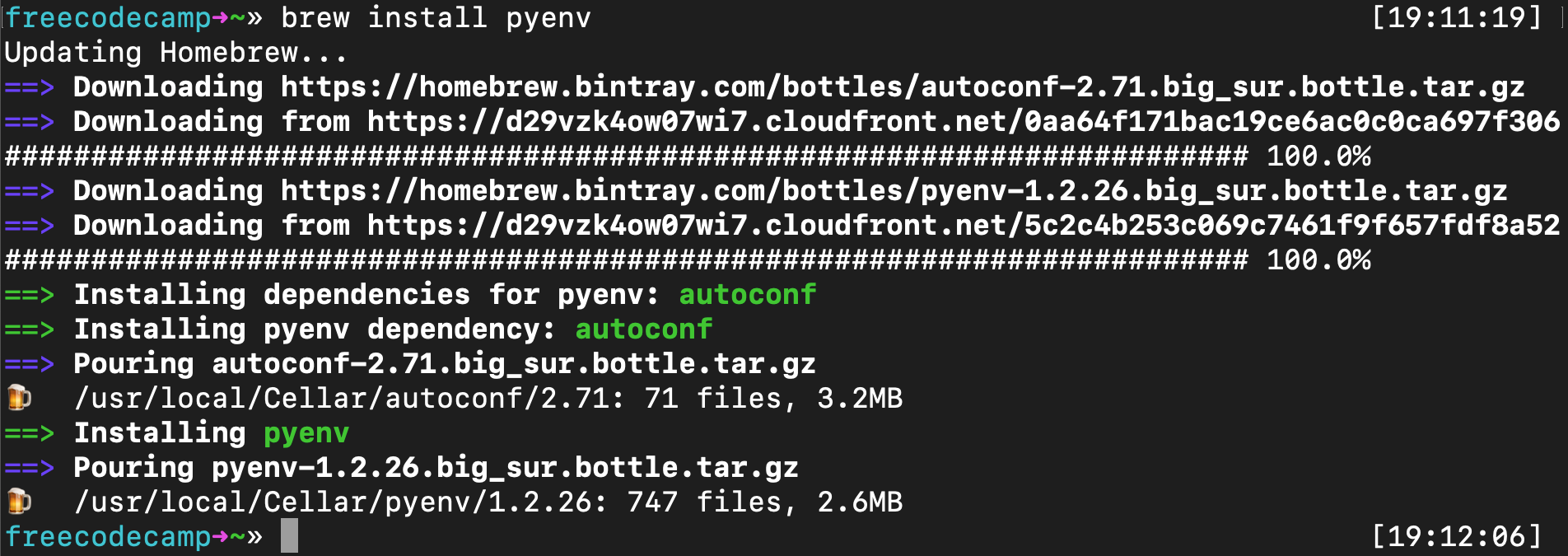
- #Brew install opencv for python3 how to
- #Brew install opencv for python3 install
- #Brew install opencv for python3 update
- #Brew install opencv for python3 code
- #Brew install opencv for python3 download
#Brew install opencv for python3 update
Next, we’ll update our package definitions: $ brew updateįollowed by updating your ~/.bash_profile using the nano terminal editor (any other editor should do the trick as well): $ nano ~/.bash_profileĪdd the following lines to the file: # Homebrewįigure 2: Editing the ~/.bash_profile to ensure that Homebrew is set up with your PATH.
#Brew install opencv for python3 install
You may already have it on your system, but if you don’t you will want to follow the commands in this section to install it.įirst, we’ll install Homebrew by copying and pasting the entire command into your terminal: $ /usr/bin/ruby -e "$(curl -fsSL )" Homebrew (also known as Brew), is a package manager for macOS. Step #2: Install Homebrew on macOS Mojave
#Brew install opencv for python3 download
Finally, a download progress window will launch and you’ll need to wait a few minutes. From there, you’ll have to accept another agreement (this time with a button).

This will launch a window where you need to press “Install“. The next step is to install Apple command line tools: $ sudo xcode-select -install Press “enter” then scroll to the bottom with the “space” key and then type “agree”. Figure 1: Download Xcode for macOS Mojave prior to setting up your system for deep learning.Īfter Xcode has been downloaded and installed from the App Store, open a terminal and execute the following command to accept the developer license: $ sudo xcodebuild -license Let’s begin! Step #1: Install and configure Xcodeįor starters, you’ll need to get Xcode from the Apple App Store and install it. If you’ve run into this conundrum, then my install guide is for you. The TensorFlow team is definitely working on Python 3.7 support - but if you’re running macOS Mojave you probably don’t want to twiddle your thumbs and wait until Python 3.7 support is officially released. This presents a challenge to us in the deep learning community because Tensorflow does not yet officially support Python 3.7. You see, Homebrew now by default installs Python 3.7. Inside of Step #3, we’ll do some Homebrew formulae kung fu to get Python 3.6 installed. Inside of this tutorial, we’ll review the seven steps to configuring Mojave for deep learning. macOS Mojave: Install TensorFlow and Keras for Deep Learning
#Brew install opencv for python3 how to
To learn how to configure macOS for deep learning and computer vision with Python, just keep reading. If you’re ready with a fresh install of macOS Mojave and are up for today’s challenge, let’s get started configuring your system for deep learning.Īlso released today is my Ubuntu 18.04 deep learning configuration guide with optional GPU support. I’m still actually running High Sierra on my machines, but after putting this guide together I feel confident in recommending Mojave to PyImageSearch readers.Īpple has fixed most of the bugs, but as you’ll see in this guide, Homebrew (an unofficial package manager for macOS) doesn’t make everything especially easy. The OS was plagued with problems from the get-go, and I decided to hold off. Inside this tutorial, you will learn how to configure macOS Mojave for deep learning.Īfter you’ve gone through this tutorial, your macOS Mojave system will be ready for (1) deep learning with Keras and TensorFlow, and (2) ready for Deep Learning for Computer Vision with Python.Ī tutorial on configuring Mojave has been a long time coming on my blog since the Mojave OS was officially released in September 2018.
#Brew install opencv for python3 code
It should take just a few seconds to complete execution.Click here to download the source code to this post The final step here is to execute - sudo make install. After it’s done you should get an output like so.

You can adjust the j option with respect to the hardware available. With all the eight cores ( j8 stands for eight cores here) chugging along, this step took ~8 minutes for me. Next, we launch the make command - make -j8. The compilation took ~3 minutes for me and it should produce outputs like so.

Now, before you run the above cmake command, activate the conda environment you created in an earlier step ( conda activate ) if you haven’t already. For these two arguments, you would want to first determine the paths and then supply them accordingly.

Also, please pay attention to the following arguments - OPENCV_EXTRA_MODULES_PATH and PYTHON3_EXECUTABLE. D PYTHON3_EXECUTABLE =/Users/sayakpaul/miniforge3/envs/dev/bin/python3 \Īs per this issue comment, DCMAKE_SYSTEM_PROCESSOR, DCMAKE_OSX_ARCHITECTURES, DWITH_OPENJPEG, and DWITH_IPP are needed to be set during the compilation step. D OPENCV_EXTRA_MODULES_PATH =/Users/sayakpaul/Downloads/opencv_contrib-4.5.0/modules \


 0 kommentar(er)
0 kommentar(er)
